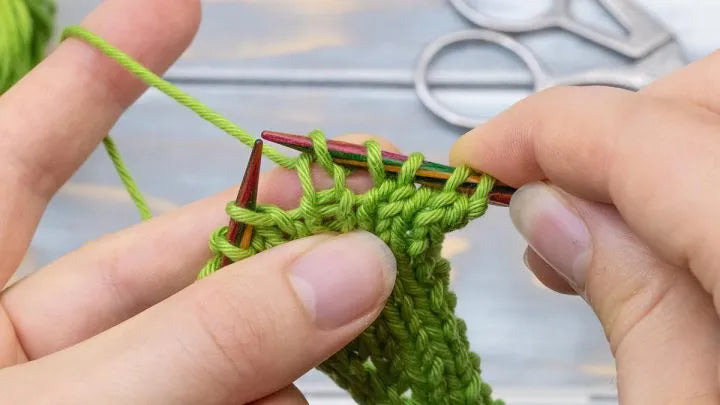
How to Do a Yarn Over: A Step-by-Step Guide for Crocheters
|
|
Time to read 6 min
|
|
Time to read 6 min
Table of content
A yarn over is a fundamental technique in knitting that serves as a building block for many patterns, particularly in lace work. This simple yet versatile stitch creates an extra loop on your needle, resulting in a decorative hole, known as an eyelet, in your fabric. Understanding how to execute a yarn over correctly is essential for both beginners and experienced knitters, as it can significantly enhance the texture and visual appeal of your projects.
Whether you're looking to add delicate details to shawls, create airy patterns in sweaters, or simply increase the number of stitches in your work, mastering the yarn over will open up a world of creative possibilities. This guide will walk you through the step-by-step process of performing a yarn over, including variations for different techniques and common mistakes to avoid. With practice, you'll find that incorporating yarn overs into your knitting repertoire is not only easy but also incredibly rewarding. So grab your needles and yarn, and let’s dive into the art of the yarn over!
💡 Did you know
The history of the yarn over technique in knitting can be traced back to the development of knitting itself, which began around the 11th century in Egypt. Early knitted items included intricate patterns that utilized various techniques, including the yarn over, to create decorative holes known as eyelets. The first European examples of yarn overs appeared in the mid-16th century, particularly in luxurious silk stockings favored by nobility, such as those worn by Eleanora de Toledo.
As knitting evolved, so did the use of yarn overs, becoming a staple in lace knitting and textured patterns. The technique gained popularity during the Victorian era, where it was often featured in elaborate designs. Today, yarn overs remain a fundamental skill for knitters, used to create beautiful lacework and increases in a variety of projects. This essential technique not only enhances the aesthetic appeal of knitted items but also showcases the rich history and evolution of knitting as an art form.
A yarn over (often abbreviated as "yo") is a technique used in knitting to create an extra stitch and a small hole, known as an eyelet, in your fabric. This technique is commonly used in lace knitting but can also be found in various other patterns. When executed correctly, yarn overs add texture and visual interest to your work.
This is the most common way to perform a yarn over. Here’s how to do it:
Step-by-Step Instructions:
Performing a yarn over between purl stitches follows a similar process but requires holding the yarn differently.
Step-by-Step Instructions:
In some patterns, you may need to create a double yarn over (abbreviated as "dyo"). This technique adds even more stitches and creates larger eyelets.
Step-by-Step Instructions:
1. Forgetting to Knit or Purl After a Yarn Over: One common mistake is forgetting to knit or purl after performing a yarn over. This can lead to unexpected results in your fabric and may cause confusion later on.
2. Misplacing Your Yarn: Ensure that you are correctly positioning your working yarn before performing a yarn over; otherwise, it can lead to uneven tension or missed stitches.
3. Not Counting Stitches: When using yarn overs for increases, always keep track of your stitch count. It’s easy to lose track if you’re not careful, especially in complex patterns.
1. Lace Knitting: Yarn overs are fundamental in lace knitting patterns, where they create intricate designs featuring open spaces and delicate motifs.
2. Textured Patterns: In addition to lace knitting, many textured patterns utilize yarn overs for added depth and visual interest.
3. Buttonholes: Yarn overs can also be used when creating buttonholes in garments such as cardigans or sweaters.
1. How do you perform a yarn over?
2. When should I use a yarn over?
3. Is there a difference between yarn over knitwise and purlwise?
4. What does a yarn over look like in my finished project?
5. Can I use a yarn over in any pattern?
6. How do I fix mistakes with yarn overs?
7. What if I accidentally drop my stitch during a yarn over?
8. Where can I find tutorials for learning more about yarn overs?


